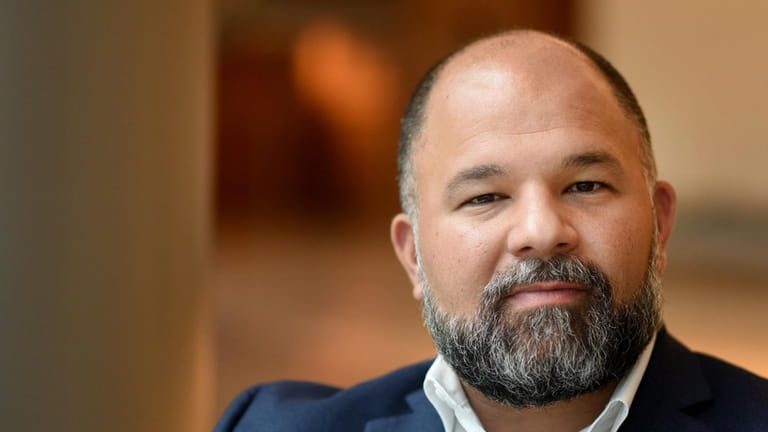Health worker burnout reaches 'crisis levels' as harassment doubles, CDC says

“Burnout among these workers has reached crisis levels," Dr. Debra Houry, the CDC’s chief medical officer, said Tuesday. Credit: CDC
More than double the number of health care workers reported harassment at work in 2022 compared with 2018 contributing to high rates of burnout and stress, according to a Centers for Disease Control and Prevention report released Tuesday.
Reports of being harassed at work were 13.4% in 2022, compared with 6.4% in 2018, according to the CDC. More than 45% of health care workers reported feeling burnout often or very often in 2022, compared with 32% in 2018, according to the report. Among workers who said they felt harassed, 85% reported feelings of anxiety and 60% reported feelings of depression.
Margaret Passley, a home health aide from Coram, said family members often ask aides to perform duties outside what they are allowed, and get angry when they don’t comply.
“The family members can be stressed for whatever reason and they bring it into where the patient is and the aide that is there,” she said.
WHAT TO KNOW
- Health care workers across the U.S. are reporting higher levels of harassment, burnout and other mental health issues, according to a new study by the CDC.
- Officials called it a “crisis” and urged employers and health care systems provide more support for workers and include them in workplace decisions.
- Healthcare workers from Long Island agreed with the findings, saying stress levels have increased since the COVID-19 pandemic started.
“Since COVID, I can say that there is more stress on the job,” she added. “The stress comes from the patient and also comes from the family members.”
The COVID-19 pandemic “intensified” long-standing challenges that health care workers face and contributed to “new and worsening concerns,” including substance use disorders and suicidal thoughts, said Dr. Debra Houry, the CDC’s chief medical officer, in a call with a reporter Tuesday.
“Burnout among these workers has reached crisis levels,” Houry said. “Usually health workers care diligently for others in their time of need. It is now our nation's health workers who are suffering and we must act.”
Hermanuella Hyppolite, director of the statewide peer assistance program at the New York State Nurses Association, said she was not surprised to hear about the increase in harassment complaints.
“Patients come into the emergency department more anxious. They have more difficulty managing their anger and they tend to take it out on the nurses,” she said.
The CDC report compared a 2022 nationwide survey of 1,952 workers, including 325 health workers, with a similar survey in 2018.
Dimitri Dauphin of Freeport, who works in the dietary department of a hospital on Long Island, said he and his colleagues were not given protective equipment to wear early in the pandemic because it was reserved for clinical staff. That changed after one of his co-workers got COVID-19 and died, he said.
That stress has carried through to today, he said. "You have a lot of new mandates at work, your supervisors are still hovering over you and you have to worry about making sure you are safe for the patients," he said.
CDC officials encouraged health care systems and other employers to provide a more positive environment and focus on the mental health of their workers. Respondents who said they trusted management, had help from their supervisors and felt their concerns were heard generally reported less burnout and poor mental health symptoms.
Data in the report showed that “the odds of depression symptoms were half when health workers could take part in workplace decisions,” said Dr. L. Casey Chosewood, director of the CDC’s National Institute for Occupational Safety and Health's office for total worker health.
Vicki Kahaner, vice president of employee relations, human resources at Northwell Health said the CDC report mirrors what has been seen across the nation and that the health care system has put “a lot of focus on making sure that our team members are getting the support they need.”
For example, Northwell has a group of peers and professionals available to employees experiencing a crisis, whether personal or professional.
Adam Gonzalez, a licensed clinical psychologist and vice chair of Behavioral Health at Stony Brook Medicine, said the health system has programs to boost employee wellness and safety, including training sessions for managers and access to one-on-one sessions with a psychologist.

Adam Gonzalez, a licensed clinical psychologst at Stony Brook Medicine, said the health system has programs to boost employee wellness and safety. Credit: Danielle Silverman
“There are town hall meetings where employees have the ability to ask questions and also stay informed about any changes,” said Gonzalez, adding there is a resilience room where employees can go to relax as well as mindfulness and meditation sessions.
Registered nurses are among the most difficult to recruit and retain on Long Island, while thousands of other health care positions are open, according to an analysis released in April by the Center for Health Workforce Studies, which is based at The University at Albany.
While the number of health care jobs on Long Island increased between 2017 and 2021, the report said “there are almost 9,900 projected average annual openings in the Long Island region for home health and personal care aides, nearly 2,700 projected average annual openings for registered nurses, and over 2,000 projected average annual openings for nursing assistants.”
“Prior to COVID, nurses have always been at a high risk for depression anxiety, but working in high-risk areas such as the ER, ICUs and now COVID areas has increased that pressure,” Hyppolite said.

